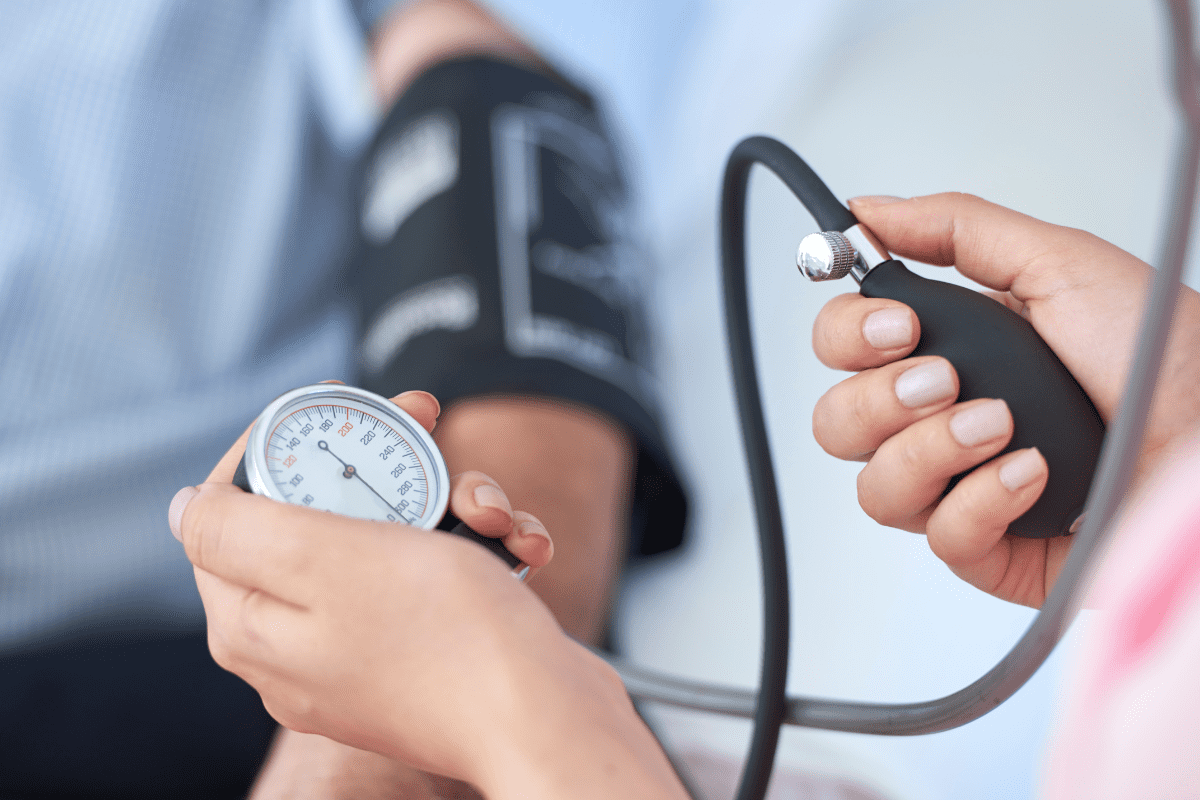
- What is blood pressure?
- What’s the difference between blood pressure and heart rate?
- When is blood pressure normal?
- Can my blood pressure be too low?
- What is high blood pressure?
- Can I improve my blood pressure?
At all times, blood is coursing through your body, feeding your organs and muscles the vital nutrients and oxygen they need to function. Controlled by the beating of your heart, blood can move at different speeds through your veins, exerting pressure as it flows through your arteries.
Since your blood affects nearly every system in your body, measuring blood pressure can tell doctors a lot about the health of your heart, veins, and the vast network of organs in your body.
In this article, we’ll discuss what blood pressure is, how it functions in your body, and why keeping your levels in the normal range is so important to your health.
What Is Blood Pressure?
Blood pressure measures the force of blood against the walls of your arteries as it courses through your veins. As the heart beats, it generates pressure that pushes the blood through this dense network of veins, carrying oxygen-rich blood to the rest of the body.
The body regulates blood pressure through a complex system that involves the heart, blood vessels, and hormones. The blood vessels constrict or dilate to adjust the blood flow, regulating pressure. Hormones such as adrenaline and renin also regulate blood pressure by constricting or dilating blood vessels and affecting the body’s water and salt balance.
Blood pressure is typically measured in millimeters of mercury (mmHg) and expressed as two numbers:
- Systolic Pressure (the higher number—when your heart pushes out blood)
- Diastolic Pressure (the lower number—when your heart rests between beats)
For example, if your blood pressure is 140/90mmHg, your systolic pressure is 140mmHg, and your diastolic pressure is 90mmHg.

What’s the Difference Between Blood Pressure and Heart Rate?
Blood pressure and heart rate (pulse) are different but closely related.
Blood pressure measures the force of blood against the artery walls as the heart pumps it through the body. Heart rate—or your pulse—is a measurement of the number of times the heart beats every minute.
Doctors measure blood pressure through an instrument called a sphygmomanometer. This device is easily recognizable for most people and consists of an inflatable cuff, a squeezable hand pump, and a gauge or a digital display. The measurement is usually taken with the cuff around the upper arm, or on the finger or wrist.
Sphygmomanometry (blood pressure test) involves two steps:
- Inflating the cuff until it is tight enough to compress the arm’s upper artery and slow/stop blood flow
- Deflating the cuff to release the artery as the healthcare provider listens through a stethoscope
As the cuff deflates, the first sound heard through the stethoscope is the systolic pressure (the higher number). As the cuff continues to deflate, the point where the sound disappears is the diastolic pressure (the lower number).
While many tests are taken by doctors, patients can also use automatic blood pressure monitors at home. Readings are displayed on the device or your smartphone and are taken electronically.
By contrast, doctors measure your heart rate by feeling the beat of the heart through the radial artery in the wrist, the carotid artery in the neck, or the femoral artery in the thigh.
To take this measurement, your healthcare professional will:
- Place the tips of their first two fingers on the radial artery
- Press lightly to feel for a pulsing sensation
- Count the number of pulses felt in one minute to find the heart rate
Like blood pressure, your heart rate can vary depending on activity, stress, or other factors, so it’s best to measure your pulse when relaxed.

When Is Blood Pressure “Normal?”
Blood pressure is generally considered normal if it falls within the range of 90/60 mmHg to 120/80 mmHg. These are the standard ranges used by healthcare providers based on guidelines from the American College of Cardiology and the American Heart Association.
A reading below 90/60 mmHg is considered low blood pressure and a reading over 120/80 is high blood pressure. However, blood pressure can fluctuate throughout the day and be affected by factors such as stress, caffeine, and certain medications.
As you might expect, blood pressure varies between people, and what is “normal” for one person may not be the same for someone else.
Speak with your healthcare provider to determine what is normal for you. Once they determine your baseline, your provider will monitor your blood pressure regularly to ensure it remains at a healthy level.

Can My Blood Pressure Be Too Low?
Blood pressure can also drop too low, resulting in a condition known as hypotension. Low blood pressure is caused by several factors:
- Anemia
- Medication
- Dehydration
- Underlying Medical Conditions
Some people have naturally low blood pressure and may not experience any complications or symptoms. However, in many cases, patients experience low blood pressure symptoms such as:
- Dizziness
- Fainting
- Fatigue
Low blood pressure can sometimes be severe, leading to shock or even organ damage. Because of this, patients who experience these symptoms should consult with their healthcare provider immediately to determine the cause and appropriate treatment.

What Is High Blood Pressure?
High blood pressure—or hypertension—occurs when blood pressure is consistently too high. High blood pressure is a potentially serious concern that can cause damage to your blood vessels and organs, including your heart, brain, and kidneys. Over time, hypertension can also lead to serious health problems such as:
- Heart Disease
- Kidney Failure
- Stroke
While high blood pressure can cause noticeable symptoms, many people with hypertension experience no ill effects until major complications occur. For this reason, hypertension has been dubbed a “silent killer.” However, those with symptoms may experience:
- Dizziness
- Headaches
- Nosebleeds
If your blood pressure is too high, it’s important to take steps to lower it through lifestyle changes or medication. Your doctor will monitor and manage your blood pressure to reduce your risk of complications.

Can I Improve My Blood Pressure?
Individuals with high or low blood pressure can take several precautions and proactive steps to improve their blood pressure levels:
- Dietary Changes
- Reduce consumption of sodium and saturated fats
- Exercise regularly
- Maintain a healthy weight
- Avoid stressful situations
- Limit alcohol consumption
- Stop smoking
- Take approved blood pressure medications
Be consistent and patient in your efforts to improve your blood pressure. Just remember that any lifestyle changes you make may take time to show results.
Need help controlling your blood pressure? At AMA Medical Group, our experienced providers can help you manage your blood pressure, improving the health of your heart to reduce your risk of complications.




